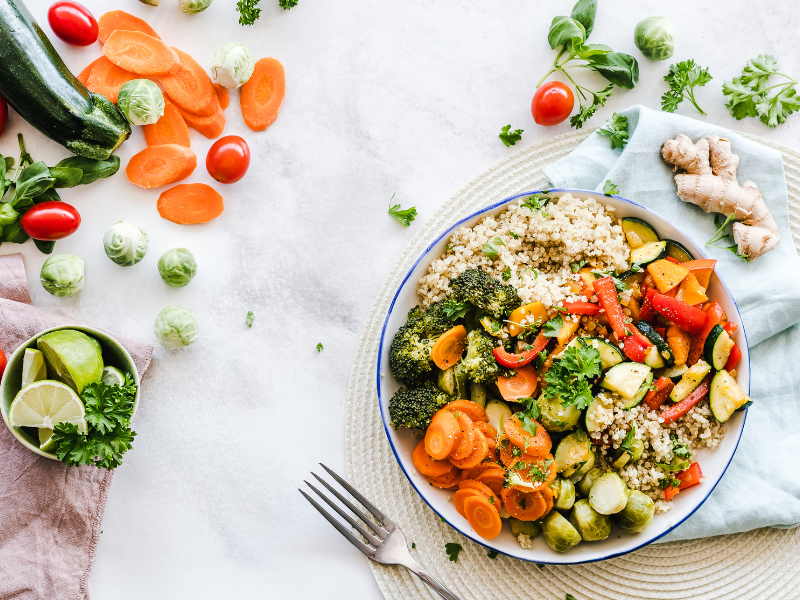


Here comes yet a new viral trend from TikTok that promises to be an effective weight loss diet, the main pull factor being that you don’t have to really restrict certain foods, but consume a variety of healthy ones in a specific quantity. So could the 90-30-50 diet plan actually be worth checking out?
The weight loss industry sure can be a saturated market filled with fads and trends, but sometimes an effective strategy is born. In this article, we try to find out if the 90-30-50 diet plan is one of them – breaking down how it works and if it’s an effective and safe method for losing weight!
What is the 90/30/50 Diet Plan?
Created by Courtney Kassis, RD, LDN who is a nutritionist and influencer, this diet simply requires you to consume 90 grams of protein, 30 grams of fiber, and 50 grams of healthy fats every day. Kassis claims to have dropped 15 pounds and lost 2% body fat in just two months since having gone on the weight loss diet. Now, she declares that she’s lost 55 pounds postpartum and put her Hashimoto’s into remission:
Kassis also explains in another video that she does not believe in restrictive diets, and that after fulfilling the 90-30-50 quota by prioritizing protein, fiber, and healthy fats, carbs come in. However, it’s good for them to come from whole, unprocessed, and low-glycemic sources.
Can You Actually Lose 15 Pounds in 2 Months?

As this diet majorly focuses on protein, it can definitely contribute to weight loss. A study by The International Journal of Obesity showed how a 20% increase in protein intake led to 50 percent lower weight regain. Protein, healthy fats, and fiber-rich foods all leave you feeling fuller and increase satiety. If an individual were to focus on these foods and naturally eliminate processed and sugary food and drinks, losing 15 pounds in 2 months can be a possibility. This balanced diet should also be combined with effective workouts for weight loss.
To plan your weight loss goals, check your Body Mass Index with our BMI Calculator.
What are the benefits of the 90/30/50 Diet Plan

- As a result of a high-protein diet, there is an increased metabolic rate since protein digestion requires more energy, burning more calories even while the body is at rest [1].
- The whole foods and nutrients consumed are also highly recommended for muscle building, especially protein and healthy fats. So say hello to muscle growth and lean muscle mass with your new dietary plan.
- Fiber is a major player in improving gut health and improving digestion.
- Healthy fats protect you against heart diseases, diabetes, and other chronic diseases [2]. Healthy fats also promote metabolism and support fat-burning processes.
- Protein helps to balance blood sugar levels and regulate hormones [3].
- The recommended diet rich in micro and macronutrients, protein, fiber, and other healthy foods helps keep cravings at bay and increases satiety [4]. This automatically will help you lose weight and have sustainable weight loss, along with all the other health benefits brought on by vitamins, minerals, and antioxidants.
You may also like:
How Many Calories Should I Burn a Day?
7-Day Low Cholesterol Diet Plan That is Simple and Nutritious!
Foods you can eat and foods to avoid

The 90-30-50 diet promotes the intake of any food group as long as it fulfils the nutrient quota. However, although it’s not a restrictive diet, if you wish to achieve the full benefits of it we recommend certain foods to eat and avoid for a nutritious weight loss diet.
Foods to Eat:
- Leafy vegetables like broccoli, kale, spinach, and Brussels sprouts
- Fresh fruits which include strawberries, blueberries, oranges, apples, and pears
- Lean protein and lean meats like turkey and chicken breast, and plant-based protein like cottage cheese, lentils, and chickpeas. You can also include other meat sources like beef once in a while.
- Whole grains like brown rice, whole-wheat pasta, whole-grain bread, quinoa, oats, and sweet potatoes.
- Healthy fats like salmon, almonds, nuts, chia seeds, avocado, and olive oil.
Foods to Avoid:
- Sugary Foods and treats such as candy, chocolate bars, and beverages like soda and fruit juices.
- Products containing trans fat and hydrogenated oils such as margarine and fried items.
- Refined Carbs in items like white bread, pastries, and sweetened cereals.
- High-calorie drinks and liquors that contain added sugars.
- Cuts of fatty meats that are high in fat, as well as processed options like sausages and bacon.
You may also like:
No Sugar No Flour Diet: The Ultimate Fat-Burning Solution
The No Added Sugar Diet: What Is It and Who Is It For?
7-Day Meal Plan for 90-30-50 Diet [Free PDF]

Now that we’ve explored all the details of the diet, we are also providing you with the resources to follow it if you choose to. Download the 7-day 90-30-50 diet plan that’s filled with ideas and inspiration for recipes to meal prep. Just print the free PDF tool and hang it in your kitchen for reference – we’re certain you won’t get enough of these flavorful and healthy recipes.
Day 1
- Breakfast: Strawberry and Greek yogurt smoothie
- Lunch: Coriander salmon with quinoa
- Dinner: Chicken curry with cauliflower rice
Day 2
- Breakfast: Muesli with dates and berries
- Lunch: Chicken breast and avocado salad
- Dinner: Rocket salad with stir-fry tofu and goat cheese
Day 3
- Breakfast: Cinnamon and protein powder porridge
- Lunch: Grilled Salmon with steamed vegetables
- Dinner: Turkey meatballs with roasted carrots and hummus
CTA BANNER
Day 4
- Breakfast: Banana and almond smoothie
- Lunch: Brown rice with grilled chicken breast and broccoli
- Dinner: Spinach, mushroom and egg frittata
Day 5
- Breakfast: Peas and feta breakfast wrap
- Lunch: Ground beef, carrot, and cabbage skillet.
- Dinner: Tofu tacos with black beans
Day 6
- Breakfast: Oats with fresh fruit and chia seeds
- Lunch: Shrimp, brown rice, roasted vegetables
- Dinner: Sweet potato dhal with curried vegetables and brown rice
Day 7
- Breakfast: Whole wheat toast with chia jam and flax seeds
- Lunch: Chicken and tofu stir fry with cauliflower rice
- Dinner: Quinoa stuffed roasted bell peppers
Conclusion

We hope this article gives you some insight into the viral 90-30-50 diet and you can now make an informed choice on whether you would like to pursue this diet plan or not. It is always important to consult a medical physician or registered dietitian before attempting any drastic weight loss strategy and to also combine a diet with the right exercises to get your desired results. For tips and resources to lose weight and more, check out the JustFit app!
What is the 90 30 50 diet plan?
How can I lose 15 lbs in 2 months?
Does the 90/30/50 method work?
Bhupathiraju, S. N. (2023, February). Carbohydrates, proteins, and fats - carbohydrates, proteins, and fats. MSD Manual Consumer Version. Available at: https://www.msdmanuals.com/home/disorders-of-nutrition/overview-of-nutrition/carbohydrates-proteins-and-fats#Carbohydrates_v60557845
Franz M. J. (1997). Protein: metabolism and effect on blood glucose levels. The Diabetes educator, 23(6), 643–651. Available at: https://doi.org/10.1177/014572179702300603
Institute of Medicine (US) Committee on Diet and Health; Woteki CE, Thomas PR, editors. Eat for Life: The Food and Nutrition Board's Guide to Reducing Your Risk of Chronic Disease. Washington (DC): National Academies Press (US); 1992. Chapter 6, Fats, Cholesterol, And Chronic Diseases. Available at: https://www.ncbi.nlm.nih.gov/books/NBK235018
Leidy H. J. (2014). Increased dietary protein as a dietary strategy to prevent and/or treat obesity. Missouri medicine, 111(1), 54–58. Available at: https://pmc.ncbi.nlm.nih.gov/articles/PMC6179508/
Shomon, M. (2024, August 27). Remission in Hashimoto’s disease and hypothyroidism: Paloma health. RSS. Available at: https://www.palomahealth.com/learn/remission-hashimotos-disease-hypothyroidism?srsltid=AfmBOopGa5XmrQMLrWvP41DyrmTbqJ-LPC_GLu3ZRKXSaUUDuHPmuHY1
Westerterp-Plantenga, M., Lejeune, M., Nijs, I. et al. High protein intake sustains weight maintenance after body weight loss in humans. Int J Obes 28, 57–64 (2004). Available at: https://doi.org/10.1038/sj.ijo.0802461





